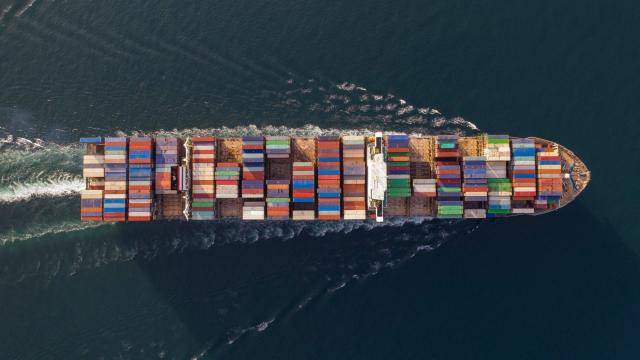Newly obtained data shows how 15 companies — including big names like Walmart, IKEA, and Amazon — are responsible for millions of tons of pollution and carbon emissions from an often-overlooked sector of their business: importing goods into the U.S. on cargo ships. A new report released Tuesday by Pacific Environment and Stand.earth uses hard-to-get data on international shipping to definitively trace just how much environmental damage some of these big companies are causing by importing goods.
We ship a lot of stuff. Today, about 80% of global trade is circulated around the world by about 50,000 ships, and the industry is expanding quickly; cargo volumes could grow by as much as 130% by 2050 as Amazon conquers more of the world and one-click shipping becomes more widely available around the world. Those ships run on extremely dirty (and cheap) fuel, known as “bunker fuel,” that releases a lot of pollutants. It’s estimated that maritime shipping is responsible for between 10% to 15% of the world’s sulphur oxide and nitrous oxide emissions and shipping is responsible for 2.2% of global carbon emissions.
But there’s a lot of murkiness around global shipping that makes it extremely difficult to track. International production is rarely a simple task of a Walmart factory overseas shipping Walmart products on a Walmart-owned ship to U.S. ports; there are endless shell companies, subsidiaries, and middlemen working to pass cargo off, with very little data collected and publicly released on these transactions. As a result, a lot of companies are able to find reasons to leave the carbon footprint of shipping out of net-zero calculations or promises. Amazon, for instance, got big headlines when it rolled out its Shipment Zero initiative to cut emissions from package shipping in half by 2050 — but that initiative only covers ground transportation, and doesn’t touch emissions from the ocean.
“Pollution from ocean shipping has been easy for companies to omit from their accounting because it is out of sight, out of mind for many of their customers,” Madeline Rose, the climate campaign director at Pacific Environment and lead author of the report, said in an email.
But by working with a shipping consultancy, Rose and other researchers were able to get their hands on data from journeys made by individual ships and calculate the emissions from each ship on its import trip. They then overlaid these datasets with manually verified datasets of all the retailers’ maritime imports into the U.S., which they gleaned from cargo manifests and the Journal of Commerce, tracking just how much of those emissions specific retailers were responsible for by shipping their stuff into the U.S.
The result is a pretty specific list of just how many pollutants imports for the 15 companies included in the report are responsible for. Walmart, the top polluter on the list, was responsible for more than 3.7 million metric tons of carbon dioxide from shipping in 2019 alone, the study shows — roughly equivalent to the emissions of one coal plant. Walmart, Target, and Ashley HomeStore, a furniture chain, produced more sulphur oxide and PM2.5 emissions than the largest power plant sources of these emissions in the U.S. Overall, these 15 retailers produced as much nitrous oxide, a key component of smog, as 27.4 million cars.
The report estimates that these numbers only account for a fifth of the actual emissions produced by shipping associated with these companies. There are many reasons to believe that these numbers are almost certainly a lowball. The researchers were only able to track 15% of Amazon’s shipments. The analysis wasn’t able to include shipments from shell companies or subsidiaries that aren’t clearly associated with major retailers — there simply isn’t enough data transparency to make that happen.
Nor does the analysis calculate emissions generated on return trips back overseas, a practice that can have a big carbon footprint on its own. (Rose said that IKEA, one of the retailers included in the report, actually does include ocean shipping in its supply chain calculations, and estimates that it makes up 40% of its supply chain emissions — a pretty hefty number.) The numbers were also gathered in 2019, pre-pandemic; there’s a good chance that they may look worse after last year, when e-commerce (and shipping stuff from overseas) grew around 16.5% as we were all stuck inside ordering things.
Much like aviation, the issue with decarbonizing shipping routes is that existing greener technologies, like methanol-fuelled boats, aren’t as effective over long routes; the cleaner options are also substantially more expensive than the cheap fuel ships are using now. Still, “the technology to sail cargo ships without burning an ounce of carbon exists,” Rose said. “All that’s needed are strong market signals that move shipping liners to invest in and build [a] cleaner, zero-emissions future.” Using Walmart as an example, she sketched out an idea of how a big retailer could speed up the development of greener shipping by making demands of its suppliers, ramping up the percentage of imports it brings in on cleaner boats each year.
Making those kinds of demands, though, depends largely on the public knowing just how dirty the alternatives are. But it’s never been more important to make them. The International Maritime Organisation estimates that carbon pollution from cargo ships could drastically rise between 50% to 250% if the industry doesn’t take action. Putting pressure on brands could be one way to get the industry to clean up its act.
“If retail companies are to continue manufacturing their products overseas and relying on fossil-fuelled shipping to import their products, they must take responsibility for the pollution they generate on the voyage,” Rose said. “Without including maritime shipping emissions in their corporate responsibility or climate reporting, these retail companies are not living up to the spirit of their climate commitments or their duty to the customers they serve.”
